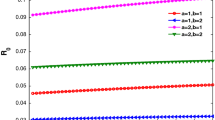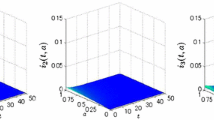Abstract
In this paper, we develop a new approach to deal with asymptotic behavior of the age-structured homogeneous epidemic systems and discuss its application to the MSEIR epidemic model. For the homogeneous system, there is no attracting nontrivial equilibrium, instead we have to examine existence and stability of persistent solutions. Assuming that the host population dynamics can be described by the stable population model, we rewrite the basic system into the system of ratio age distribution, which is the age profile divided by the stable age profile. If the host population has the stable age profile, the ratio age distribution system is reduced to the normalized system. Then we prove the stability principle that the local stability or instability of steady states of the normalized system implies that of the corresponding persistent solutions of the original homogeneous system. In the latter half of this paper, we prove the threshold and stability results for the normalized system of the age-structured MSEIR epidemic model.
Similar content being viewed by others
References
Andreasen V. (1989) Disease regulation of age-structured host populations. Theor. Popul. Biol. 36, 214–239
Andreasen V. (1993) The effect of age-dependent host mortality on the dynamics of an endemic disease. Math. Biosci. 114, 29–58
Andreasen V. Instability in an SIR-model with age-dependent susceptibility. In: Arino O., Axelrod, D., Kimmel M., Langlais M. (eds) Mathematical Population Dynamics, vol 1. pp. 3–14. Wuerz Publishing, Winnipeg, (1995)
Aron J.L. (1988) Acquired immunity dependent upon exposure in an SIRS epidemic model. Math. Biosci. 88, 37–47
Busenberg S., Hadeler K.P. (1990) Demography and epidemics. Math. Biosci. 101, 63–74
Busenberg S., Castillo-Chavez C. (1991) A general solution of the problem of mixing subpopulations and its application to risk- and age-structured epidemic models for the spread of AIDS. IMA J. Math. Appl. Med. Biol. 8, 1–29
Cushing J.M.: An Introduction to Structured Population Dynamics. CBMS-NSF Regional Conference Series in Applied Mathematics, vol. 71, SIAM, Philadelphia (1998)
Cha Y., Iannelli M., Milner F.A.: Are multiple endemic equilibria possible ?, In: Arino O., Axelrod D., Kimmel M. (eds.) Advances in Mathematical Population Dynamics. -Molecules, Cells and Man. pp. 779–788. World Scientific, Singapore (1997)
Cha Y., Iannelli M., Milner F.A. (1998) Existence and uniqueness of endemic states for the age-structured S-I-R epidemic model. Math. Biosci. 150, 177–190
Cha Y., Iannelli M., Milner F.A. (2000) Stability change of an epidemic model. Dyn. Syst. Appl. 9, 361–376
Cvjetanović B., Grab B., Dixon H. (1982) Epidemiological models of poliomyelitis and measles and their application in the planning of immunization programmes. Bull. World Health Organ. 60(3): 405–422
Diekmann O., Heesterbeek J.A.P., Metz J.A.J. (1990) On the definition and the computation of the basic reproduction ratio R 0 in models for infectious diseases in heterogeneous populations. J. Math. Biol. 28, 365–382
Diekmann O., Heesterbeek J.A.P.: Mathematical Epidemiology of Infectious Diseases: Model Building, Analysis and Interpretation. J. Wiley, Chichester (2000)
Greenhalgh D. (1990) Vaccination campaigns for common childhood diseases. Math. Biosci. 100, 201–240
Greenhalgh G. (1993) Existence, threshold and stability results for an age-structured epidemic model with vaccination and a non-separable transmission coefficient. Int. J. Systems Sci. 24(4): 641–668
Hadeler K.P., Waldstätter R., Wörz-Busekros A. (1988) Models for pair formation in bisexual populations. J. Math. Biol. 26, 635–649
Hadeler K.P., Ngoma K. (1990) Homogeneous models for sexually transmitted diseases. Rocky Mt. J. Math. 20(4): 967–986
Hadeler K.P. (1992) Periodic solutions of homogeneous equations. J. Differ. Equations 95, 183–202
Hadeler K.P. (1993) Pair formation models with maturation period. J. Math. Biol. 32, 1–15
Heijmans H.J.A.M.: The dynamical behaviour of the age-size-distribution of a cell population, In: Metz J. A. J., Diekmann O. (eds.) The Dynamics of Physiologically Structured Populations. Lect. Notes. Biomath. vol. 68. pp. 185–202, Springer Berlin Heidelberg New York (1986)
Hethcote H.W. (2000) The mathematics of infectious diseases. SIAM Rev. 42(4): 599–653
Iannelli M.: Mathematical Theory of Age-Structured Population Dynamics. Giardini Editori e Stampatori in Pisa (1995)
Iannelli M., Martcheva M.: Homogeneous dynamical systems and the age-structured SIR model with proportionate mixing incidence. In: Iannelli M., Lumer G., (eds.) Evolution Equations: Applications to Physics, Industry, Life Sciences and Economics Progress in Nonlinear Differential Equations and their applications, vol. 55,pp 227–251. Birkhäuser, Basel Boston Berlin (2003)
Inaba H. (1988a) A semigroup approach to the strong ergodic theorem of the multistate stable population process. Math. Popul. Stud. 1(1): 49–77
Inaba H. (1988b) Asymptotic properties of the inhomogeneous Lotka-Von Foerster system. Math. Popul. Stud. 1(3): 247–264
Inaba H. (1990) Threshold and stability results for an age-structured epidemic model. J. Math. Biol. 28, 411–434
Inaba H. (2001) Kermack and McKendrick revisited: the variable susceptibility model for infectious diseases. Japan J. Indust. Appl. Math. 18(2): 273–292
Inaba H. (2006) Mathematical analysis of an age-structured SIR epidemic model with vertical transmission. Discret. Contin. Dyn. Systems Series B 6(1): 69–96
Katzmann W., Dietz K. (1984) Evaluation of age-specific vaccination strategies. Theor. Popul. Biol. 25, 125–137
Krasnoselskii M.A. (1964) Positive Solutions of Operator Equations. Noordhoff, Groningen
Manfredi P., Williams J.R. (2004) Realistic dynamics in epidemiological models: the impact of population decline on the dynamics of childhood infectious diseases Measles in Italy as an example. Math. Biosci. 192, 153–175
Marek I. (1970) Frobenius theory of positive operators: comparison theorems and applications SIAM J. Appl. Math. 19, 607–628
McLean A.: Dynamics of childhood infections in high birthrate countries. In: Hoffman, G.W., Hraba T. (eds.) Immunology and Epidemiology, Lecture Notes in Biomath. vol. 65. pp. 171–197. Springer Berlin Heidelberg New York (1986)
Milner F.A., Langlais M., Busenberg S.: Non-unique positive steady states in population dynamics and epidemic models and their stability. In: Martelli M., Cooke K., Cumberbatch E. (eds.) Differential Equations and Applications to Biology and to Industry, pp. 369–383 World Scientific, Singapore (1996)
Mollison D. (ed) (1995) Epidemic Models: their Structure and Relation to Data. Cambridge University Press, Cambridge
Nagel R. (ed.): One-Parameter Semigroups of Positive Operators. Lecture are Notes in Mathematics, vol. 1184. Springer Berlin Heidelberg New York (1986)
Pazy A.: Semigroups of Linear Operators and Applications to Partial Differential Equations. Springer Berlin Heidelberg New York (1983)
Prüss J. (1981) Equilibrium solutions of age-specific population dynamics of several species. J. Math. Biol. 11, 65–84
Sawashima I. (1964) On spectral properties of some positive operators. Nat. Sci. Report Ochanomizu Univ. 15: 53–64
Thieme H.R.: Stability change for the endemic equilibrium in age-structured models for the spread of S-I-R type infectious diseases. In: Differential Equation Models in Biology, Epidemiology and Ecology. Lecture Notes in Biomath. vol. 92. pp. 139–158. Springer Berlin Heidelberg New York (1991)
Tuljapurkar S., Meredith John A.(1991) Disease in changing populations: growth and disequilibrium. Theor. Popul. Biol. 40, 322–353
Webb G.F. (1985) Theory of Nonlinear Age-Dependent Population Dynamics. Marcel Dekker, New York and Basel
Webb G.F.: Asynchronous exponential growth in differential equations with homogeneous nonlinearities. In: Dore G., Favini A., Obrecht E., Venni A., (eds.) Differential Equations in Banach Spaces. Lecture Notes in Pure and Applied Mathematics, vol. 148. pp. 225–233. Dekker, New York (1993)
Webb G.F.: Asynchronous exponential growth in differential equations with asymptotically homogeneous nonlinearities. Adv. Math. Sci. Appl. 3 43–55 (1993/94)
Yosida K. Functional Analysis, 6th edn. Springer Berlin Heidelberg New York (1980)
Author information
Authors and Affiliations
Corresponding author
Rights and permissions
About this article
Cite this article
Inaba, H. Age-structured homogeneous epidemic systems with application to the MSEIR epidemic model. J. Math. Biol. 54, 101–146 (2007). https://doi.org/10.1007/s00285-006-0033-y
Received:
Published:
Issue Date:
DOI: https://doi.org/10.1007/s00285-006-0033-y
Keywords
- Homogeneous epidemic system
- Stable population
- Stability principle
- Basic reproduction ratio
- Endemic steady state




